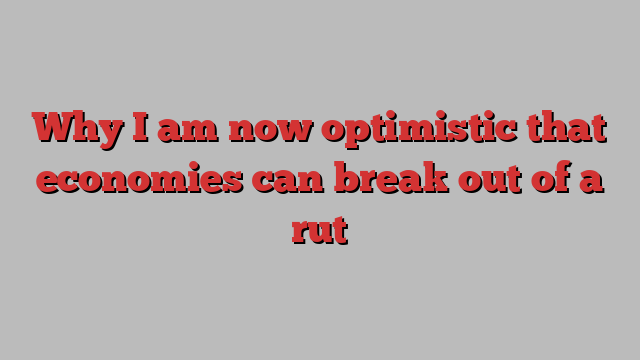
Unlock the Editor’s Digest for free
Roula Khalaf, Editor of the FT, selects her favourite stories in this weekly newsletter.
The writer is president of Queens’ College, Cambridge, and an adviser to Allianz and Gramercy
For the first time in two decades, I am optimistic that the economies of the advanced countries can decisively break out of a low-growth rut.
For too long, insufficient growth has undermined economic wellbeing, structurally weakened increasingly fragile public finances, worsened inequality and made it more difficult to address global threats to lives and livelihoods such as climate change and pandemics.
The roots of this problem can be traced back to the start of this century. Rather than focus on productivity-enhancing structural reforms, too many countries fell in love with financial services as a shortcut to growth. Some even acted as if finance provided the next stage of capitalist development — agriculture, industry, services and, now, finance.
It was a romance that saw regulators opt for “light touch” approaches and countries compete fiercely to become international financial centres. There were few worries about the decoupling of an ever-expanding financial sector from the economies it was meant to serve — that is until it became unsustainable, culminating in the global financial crisis.
Rather than treating the crisis as evidence of structural failures, too many policymakers opted for a cyclical response — or the third T in the mantra then of “timely, targeted and temporary” policy approaches. In the absence of revamped engines of growth, fiscal deficits and the balance sheets of central banks expanded in magnitude more than anyone had imagined. Meanwhile, measures to strengthen productivity were, at best, piecemeal, inconsistent, and lacked a strategic framework.
After suffering the consequences, a rising number of governments are now placing growth at the top of the policy agenda. This is illustrated most vividly by the new UK government’s “growth mission” and its urgent implementation of measures to “release the brakes”. A refreshed US administration is likely to follow suit.
This evolution is only part of the reason I am more optimistic about medium-term growth. The other is the realisation that releasing the brakes needs to be accompanied by the emergence of powerful new engines of tomorrow’s growth; and there is enough scientific evidence to suggest that such engines are not just possible but also probable.
Seemingly every year, there are more impressive innovations in areas such as artificial intelligence, life sciences and sustainable energy. Each improves not just “what” we do but also “how” we do it. The trend is being spurred by abundant private sector financing, considerable human expertise and expanding computer power.
Together with these enablers, there are other sources of potential growth from the restructuring of specific sectors, creating beneficial “spillover” effects to the broader economy. This is the case for healthcare, food security and defence where there is significant scope for direct and indirect productivity gains.
This optimism is not without challenges. Each new growth driver comes with what I call 80/20 attributes — with the potential impact 80 per cent positive but also a 20 per cent possibility of negative consequences. The challenge is to unleash the promising benefits while managing the risk. In different countries, behavioural contexts will skew this. In the US, for example, innovators might tend to focus exclusively on the 80 per cent potential benefits. In Europe, regulators might be paralysed by the 20 per cent risk.
There is also the challenge of avoiding repeating the mistake with globalisation of losing sight of distributional consequences. The labour-augmenting potential rather than labour displacement risk of these innovations must be emphasised in an early and sustained manner. Visionary leadership will play an essential role here, as well as in navigating a fragmented world in which the potential for win-win co-operation has given way to divergence and fragmentation.
Yet the challenges, as real as they are, are not enough to curb my optimism. The potential for breakout growth is real and promising.
For years, I have worried that my generation was leaving our children a world of insufficient growth, terrible inequality, collapsing public services, high debt and a damaged planet. Today, I am more hopeful that they will have powerful new tools to overcome this awful legacy and enable their kids to live in a more prosperous, sustainable and equal world.